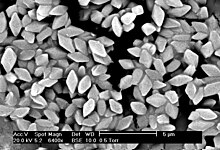| Bacillus thuringiensis | |
|---|---|

| |
| Spores and bipyramidal crystals of Bacillus thuringiensis morrisoni strain T08025 | |
| Scientific classification | |
| Domain: | Bacteria |
| Phylum: | Bacillota |
| Class: | Bacilli |
| Order: | Caryophanales |
| Family: | Bacillaceae |
| Genus: | Bacillus |
| Species: | B. thuringiensis
|
| Binomial name | |
| Bacillus thuringiensis Berliner 1915
| |
| Subspecies | |
| |

Bacillus thuringiensis (or Bt) is a gram-positive, soil-dwelling bacterium, the most commonly used biological pesticide worldwide. B. thuringiensis also occurs naturally in the gut of caterpillars of various types of moths and butterflies, as well on leaf surfaces, aquatic environments, animal feces, insect-rich environments, flour mills and grain-storage facilities.[1][2] It has also been observed to parasitize moths such as Cadra calidella—in laboratory experiments working with C. calidella, many of the moths were diseased due to this parasite.[3]
During sporulation, many Bt strains produce crystal proteins (proteinaceous inclusions), called delta endotoxins, that have insecticidal action. This has led to their use as insecticides, and more recently to genetically modified crops using Bt genes, such as Bt corn.[4] Many crystal-producing Bt strains, though, do not have insecticidal properties.[5] The subspecies israelensis is commonly used for control of mosquitoes[6] and of fungus gnats.[7]
As a toxic mechanism, cry proteins bind to specific receptors on the membranes of mid-gut (epithelial) cells of the targeted pests, resulting in their rupture. Other organisms (including humans, other animals and non-targeted insects) that lack the appropriate receptors in their gut cannot be affected by the cry protein, and therefore are not affected by Bt.[8][9]
- ^ Madigan MT, Martinko JM, eds. (2005). Brock Biology of Microorganisms (11th ed.). Prentice Hall. ISBN 978-0-13-144329-7.[page needed]
- ^ du Rand N (July 2009). Isolation of Entomopathogenic Gram Positive Spore Forming Bacteria Effective Against Coleoptera (PhD thesis). Pietermaritzburg, South Africa: University of KwaZulu-Natal. hdl:10413/1235.[page needed]
- ^ Cox PD (1975). "The influence of photoperiod on the life-cycles of Ephestia calidella (Guenee) and Ephestia figulilella Gregson (Lepidoptera: Phycitidae)". J. Stored Prod. Res. 11 (2): 77. doi:10.1016/0022-474X(75)90043-0.
- ^ Kumar PA, Sharma RP, Malik VS (1996). "The Insecticidal Proteins of Bacillus thuringiensis". Advances in Applied Microbiology Volume 42. Vol. 42. pp. 1–43. doi:10.1016/s0065-2164(08)70371-x. ISBN 978-0-12-002642-5. PMID 8865583.
- ^ Roh JY, Choi JY, Li MS, Jin BR, Je YH (April 2007). "Bacillus thuringiensis as a specific, safe, and effective tool for insect pest control". Journal of Microbiology and Biotechnology. 17 (4): 547–59. PMID 18051264.
- ^ "Bti for Mosquito Control". EPA.gov. US EPA. 2016-07-05. Retrieved 28 June 2018.
- ^ "Fungus Gnats Management Guidelines--UC IPM". ipm.ucanr.edu. University of California Integrated Pest Management.
- ^ Hall H (May 30, 2006). "Bt corn: is it worth the risk?". The Science Creative Quarterly.
- ^ Dorsch JA, Candas M, Griko NB, Maaty WS, Midboe EG, Vadlamudi RK, Bulla LA (September 2002). "Cry1A toxins of Bacillus thuringiensis bind specifically to a region adjacent to the membrane-proximal extracellular domain of BT-R(1) in Manduca sexta: involvement of a cadherin in the entomopathogenicity of Bacillus thuringiensis". Insect Biochemistry and Molecular Biology. 32 (9): 1025–36. doi:10.1016/S0965-1748(02)00040-1. PMID 12213239.